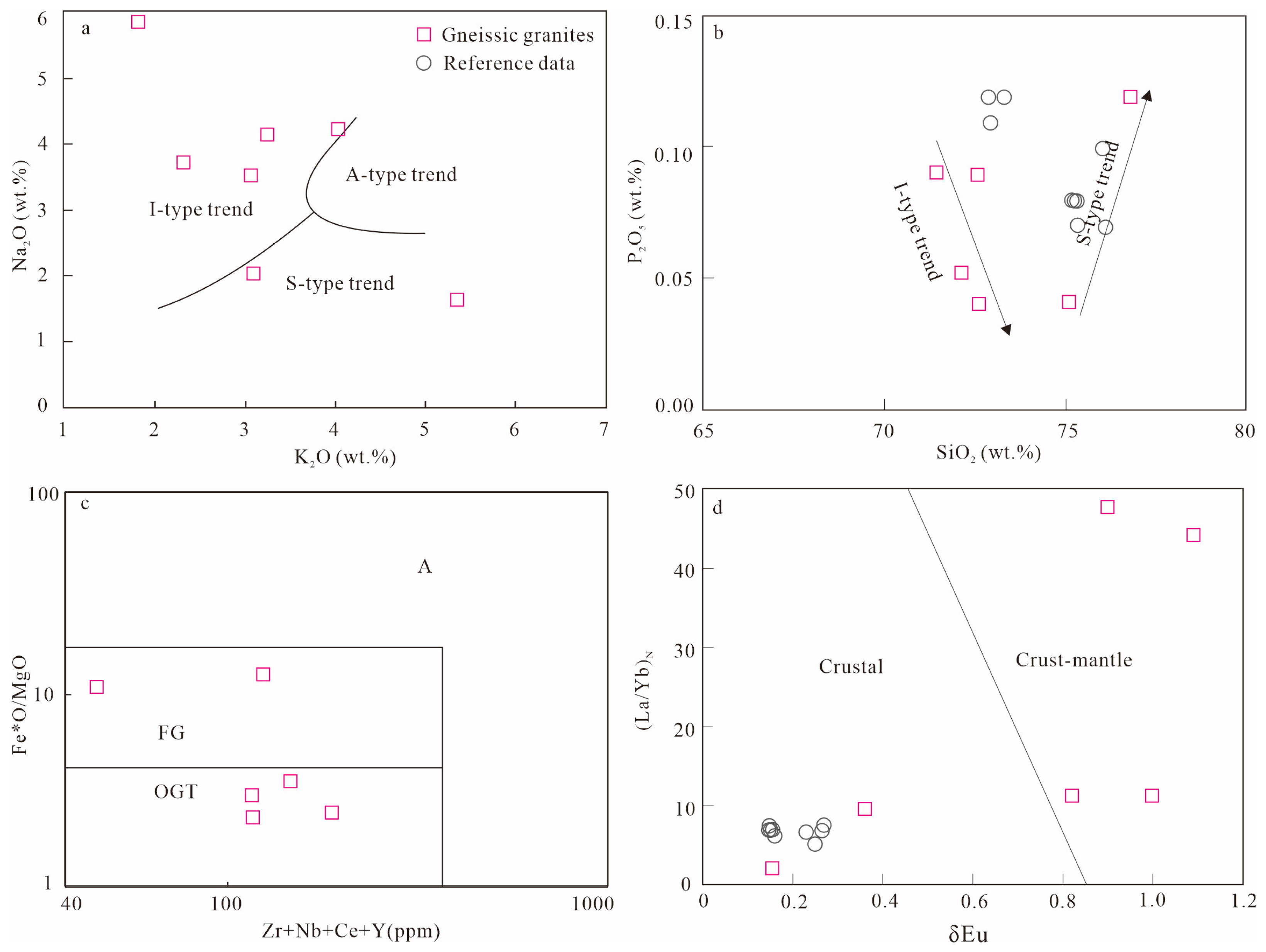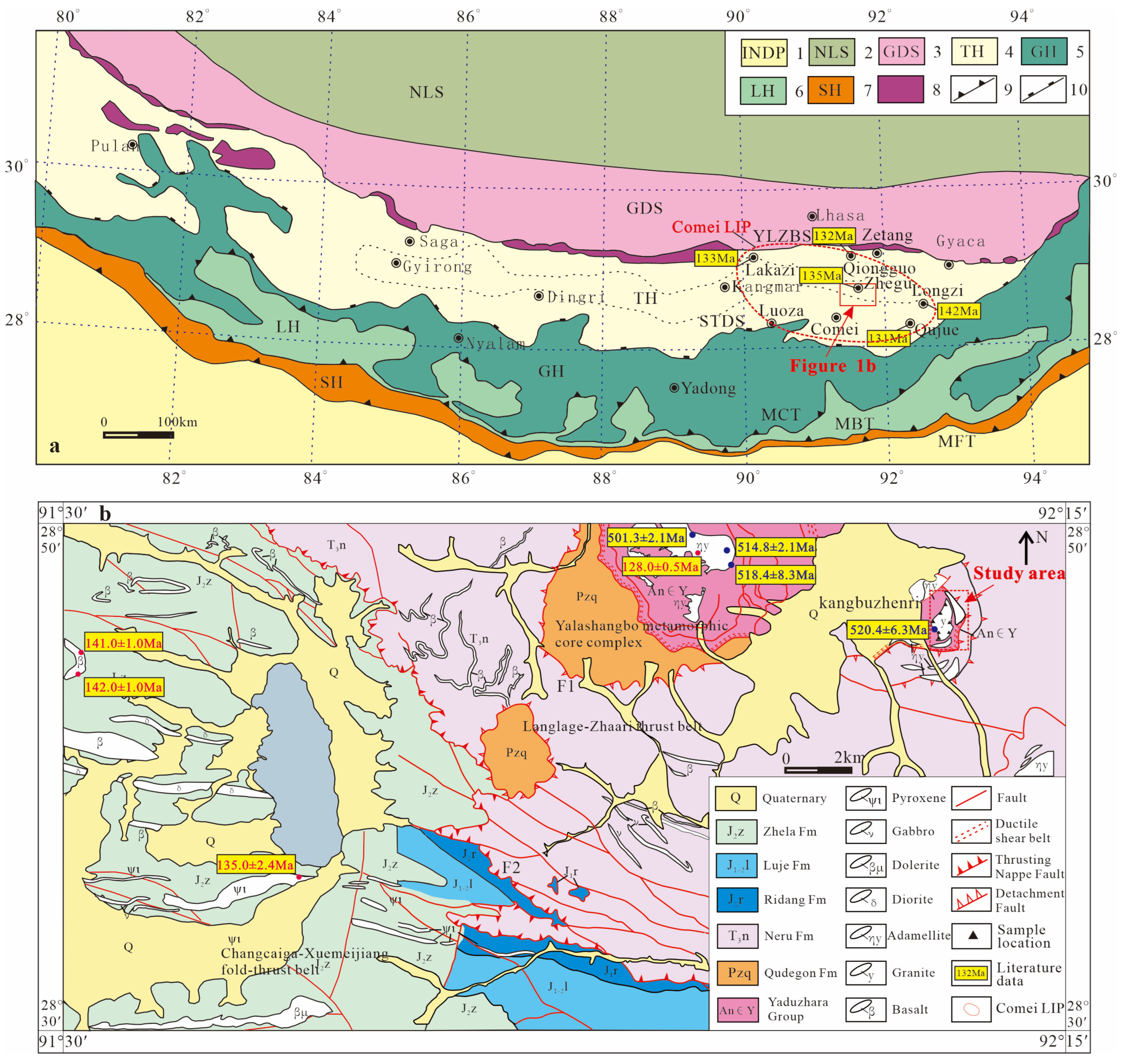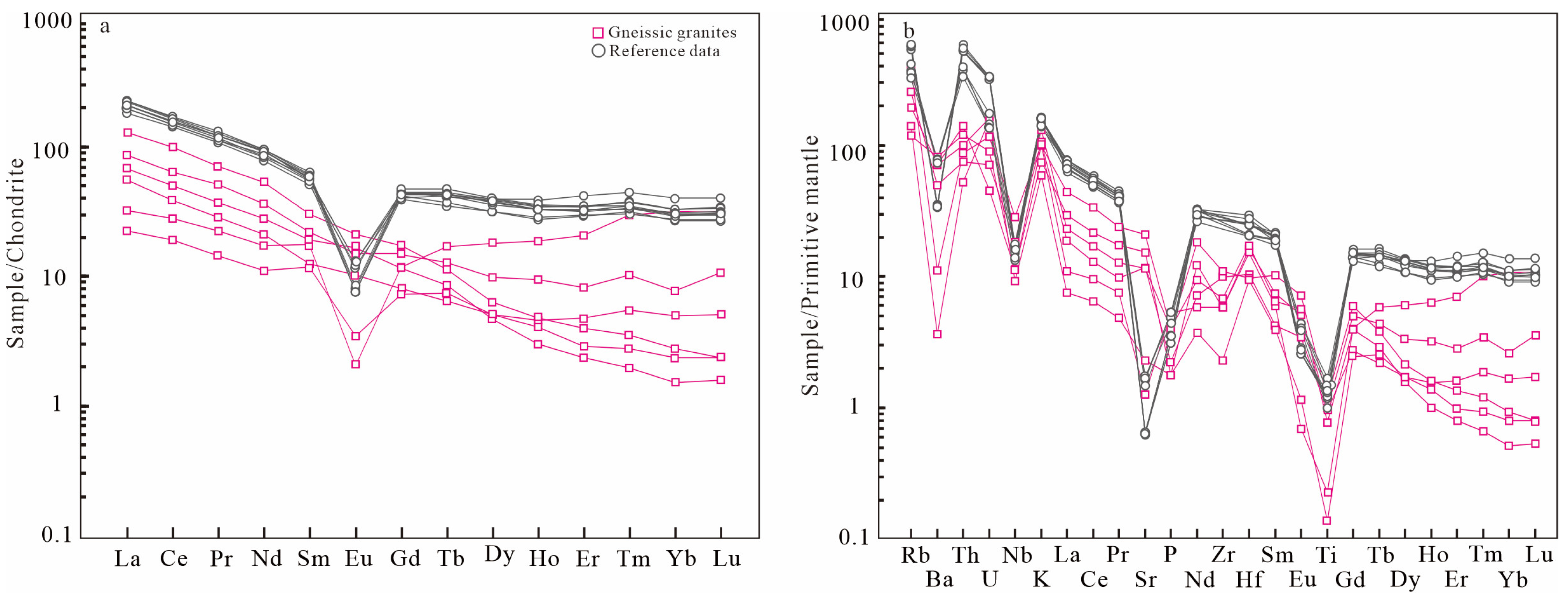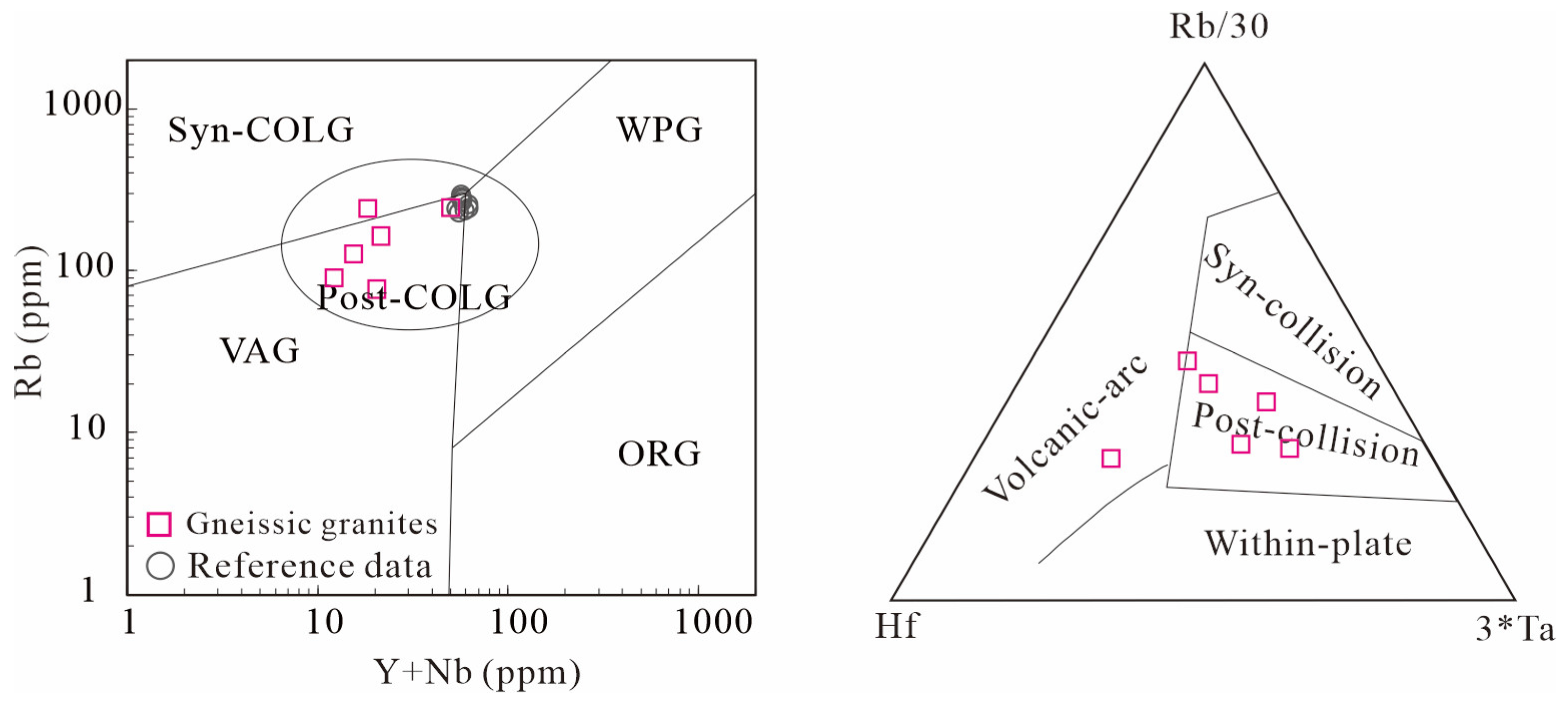Pan-African and Early Paleozoic Orogenic Events in Southern Tibet: Evidence from Geochronology and Geochemistry of the Kangbuzhenri Gneissic Granite in the Zhegu Area
Abstract
:1. Introduction
2. Geological Background
3. Analytical Methods
4. Results
4.1. Zircon U-Pb Geochronology
4.2. Characteristics of Whole-Rock Major Elements
4.3. Characteristics of Whole-Rock Trace Elements
5. Discussion
5.1. Geochronology
5.1.1. Protolith Age
5.1.2. Record of Pan-African-Early Paleozoic Events
5.1.3. Mesozoic Magmatic Tectono-Thermal Event
5.2. Petrogenesis

5.3. Geodynamic Implication
6. Conclusions
Supplementary Materials
Author Contributions
Funding
Data Availability Statement
Acknowledgments
Conflicts of Interest
References
- Wang, X.X.; Zhang, J.J.; Santosh, M.; Liu, J.; Yan, S.Y.; Guo, L. Andean-type orogeny in the Himalayas of South Tibet: Implications for Early Paleozoic tectonics along the Indian margin of Gondwana. Lithos 2012, 154, 248–262. [Google Scholar] [CrossRef]
- Cai, Z.H.; Xu, Z.Q.; Duan, X.D.; Li, H.Q.; Cao, H.; Huang, X.M. Early stage of Early Paleozoic orogenic event in western Yunnan Province, southeastern margin of Tibet Plateau. Acta Petrol. Sin. 2013, 29, 2123–2140. [Google Scholar]
- Ren, L.D.; Wang, H. The Pan-African event and its manifestation in the China continent and adjacent regions. Acta Sci. Nat. Univ. Sunyateseni 2023, 62, 1–33. [Google Scholar]
- Liu, W.-C.; Liang, D.-Y.; Wang, K.-Y.; Zhou, Z.-G.; Li, G.-B.; Zhang, X.-X. Discovery of the Ordovician in the Kangma area of southern Tibet and its geological significance. Earth Sci. Front. 2002, 9, 247–248. [Google Scholar]
- Zhou, Z.-G.; Liu, W.-C.; Liang, D.-Y. Discovery of the Ordovician and its basal conglomerate in the Kangmararea, southern Tibet-with a discussion of the relationof the sedimentary cover and unifying basement in the Himalayas. Geol. Bull. China 2004, 23, 655–663. [Google Scholar]
- Xu, Z.-Q.; Yang, J.-S.; Liang, F.-H.; Qi, X.-X.; Liu, F.-C.; Zeng, L.-S.; Liu, M.-Y.; Li, H.-B.; Wu, C.-L.; Shi, R.-D.; et al. Pan-African and Early Paleozoic orogenic events in the Himalaya terrane: Inference from SHRlMP U-Ph zircon ages. Acta Petrol. 2005, 21, 3–14. [Google Scholar]
- Li, C.; Wu, Y.-W.; Wang, M.; Yang, H.-T. Significant progress on Pan-African and Early Paleozoic orogenic events in Qinghai-Tibet Plateau-discovery of Pan-African orogenic unconformity and Cambrian System in the Gangdise area, Tibet, China. Geol. Bull. China 2010, 29, 1733–1736. [Google Scholar]
- Le Fort, P. Manaslu leucogranite: A collision signature of the Himalaya: A model for its genesis and emplacement. J. Geophys. Res. Solid Earth 1981, 86, 10545–10568. [Google Scholar] [CrossRef]
- Liu, W.-C.; Wang, Y.; Zhang, X.-X.; Li, H.-M.; Zhou, Z.-G.; Zhao, X.-G. The rock types and isotope dating of the Kangmar gneissic dome in southern Tibet. Earth Sci. Front. 2004, 11, 491–501. [Google Scholar]
- Wang, Y.-Y.; Gao, L.-E.; Zeng, L.-S.; Chen, F.-K.; Hou, K.-j.; Wang, Q.; Hou, L.-S.; Gao, J.-H. Multiple phases of cretaceous mafic magmatism in the Gyangze-Kangma area, Tethyan Himalaya, southern Tibet. Acta Petrol. Sin. 2016, 32, 3572–3596. [Google Scholar]
- Zhang, Z.; Zhang, L.K.; Li, G.M.; Liang, W.; Xia, X.B.; Fu, J.G.; Dong, S.L.; Mang, G.T. The Cuonadong Gneiss Dome of North Himalaya: A New Member of Gneiss Dome and a New Proposition for the Ore-controlling Role of North Himalaya Gneiss Domes. Acta Geosci. Sin. 2017, 38, 754–766. [Google Scholar]
- Gao, L.-E.; Zeng, L.-S.; Xie, K.-J. Eocene high grade metamorphism and crustal anatexis in the North Himalaya Gneiss Domes, Southern Tibet. Chin. Sci. Bull. 2011, 56, 3078–3090. [Google Scholar] [CrossRef]
- Hu, G.Y.; Zeng, L.S.; Qi, X.X.; Hou, K.J.; Gao, L.E. The Mid-Eocene subvolcanic field in the Lhunze-Qiaga area, Tethyan Himalaya, southern Tibet: A high-level magmatic suite related to the Yardio two-mica granite. Acta Petrol. Sin. 2011, 27, 3308–3318. [Google Scholar]
- Wu, Z.-H.; Ye, S.-P.; Wu, Z.-H.; Zhao, Z. LA-ICP-MS zircon U-Pb ages of tectonic-thermal events in the Yalaxiangbo dome of Tethys Himalayan belt. Geol. Bull. China 2014, 33, 595–605. [Google Scholar]
- Dong, L.; Li, G.-M.; Huang, Y.; Li, Y.-X.; Cao, H.-W.; Zhang, Z. Geochemical characteristics, chronology and tectonic significance of the granitic gneiss in the yardoi dome, sourthern Tibet. J Miner. Pet. 2018, 38, 76–87. [Google Scholar]
- Gao, P.; Wang, Y.; Yin, C.Q.; Zhang, J.; Qian, J.H. The change of crustal anatectic for granitic magmatisms from Eocene and Miocene in the Himalatan orogen: Geocgemical evidences pf granites. Bull. Mineral. Petrol. Geochem. 2023, 42, 998–1016. [Google Scholar]
- Zhao, X.Y.; Yang, Z.S.; Yang, Y.; Cao, Y.; Fan, B. Discovery pf Early Cretaceous metamorphic basic rocks and plagioclase amphibolite in Yalaxiangbo, Tibet and its geological significance. Earth Sci. Front. 2023, 30, 163–182. [Google Scholar]
- Liang, F.-H.; Xu, Z.-Q.; Ba, D.-Z.; Xu, X.-Z.; Liu, F.; Xiong, F.-H.; Jia, Y. Tectonic occurrence and emplacement mechanism of ophiolites from Luobusha-Zedang, Tibet. Acta Petrol. Sin. 2011, 27, 3255–3268. [Google Scholar]
- Xu, Z.-Q.; Yang, J.-S.; Li, H.-B.; Ji, S.-C.; Zhang, Z.-M.; Liu, Y. On the Tectonics of the India-Asia Collision. Acta Geol. Sin. 2011, 85, 1–33. [Google Scholar]
- Zhang, H.-F.; Harris, N.; Parrish, R.; Zhang, L.; Zhao, Z.-D. U-Pb ages of Kudui and Sakya pale granite in the Sakya Dome of the Northern Himalayas and their geological significance. Chin. Sci. Bull. 2004, 49, 2090–2094. [Google Scholar]
- Zeng, L.-S.; Liu, J.; Gao, L.-E.; Xie, K.-J.; Wen, L. Early Oligocene anatexis in the Yardoi gneiss dome, southern Tibet and geological implications. Chin. Sci. Bull. 2009, 54, 373–381. [Google Scholar] [CrossRef]
- Zeng, L.; Liang, F.; Xu, Z.; QI, X. Metapelites in the Himalayan orogenic belt and their protoliths. Acta Petrol. Sin. 2008, 24, 1517–1527. [Google Scholar]
- Zhang, J.-J.; Yang, X.-Y.; Qi, G.-W.; Wang, D.-C. Geochronology of the Malashan dome and its application in formation of the Southern Tibet detachment system (STDS) and Northern Himalayan gneiss domes (NHGD). Acta Petrol. Sin. 2011, 27, 3535–3544. [Google Scholar]
- Zhang, X.-Z.; Wang, Q.; Wyman, D.; Ou, Q.; Qi, Y.; Gou, G.-N.; Dan, W.; Yang, Y.-N. Tibetan Plateau growth linked to crustal thermal transitions since the Miocene. Geology 2022, 50, 610–614. [Google Scholar] [CrossRef]
- Zhang, Y.-M.; Kang, D.-Y.; Ding, H.-X.; Tian, Z.-L.; Dong, X.; Qin, S.-K.; Mu, H.-C.; Li, M.-M. Partial Melting of Himalayan Orogen and Formation Mechanism of Leucogranites. Earth Sci. 2018, 43, 82–98. [Google Scholar]
- Liu, S.; Zhang, G.; Zhang, L.; Liu, Z.; Xu, J. Boron isotopes of tourmalines from the central Himalaya: Implications for fluid activity and anatexis in the Himalayan orogen. Chem. Geol. 2022, 596, 120800. [Google Scholar] [CrossRef]
- Chen, H.; Hu, G.; Zeng, L.; Yu, X.; Li, Y. Miocene crustal anatexis of Paleozoic orthogneiss in the Zhada area, western Himalaya. Acta Geol. Sin.-Engl. Ed. 2022, 96, 954–971. [Google Scholar] [CrossRef]
- Gu, D.; Zhang, J.; Lin, C.; Fan, Y.; Feng, L.; Zheng, J.; Liu, S. Anatexis and resultant magmatism of the Ama Drime Massif: Implications for Himalayan mid-Miocene tectonic regime transition. Lithos 2022, 424, 106773. [Google Scholar] [CrossRef]
- Dong, J.-S.; Zhen, H.-M.; XIa, J.; Lu, R.-K.; Yang, S.-X. Geochemical features and tectonic setting of peraluminous graniten the hozag area, southern Tibet. Geol. Bull. China 2003, 22, 308–318. [Google Scholar]
- Luo, W. Geochronology, Geochemistry and Geological Significance of Leucogranite in the Hare Region, South Tibetan. Acta Geol. Sichuan 2021, 41, 3–11. [Google Scholar]
- Zhang, Y.-Q.; Dai, T.-M.; Hong, A.-S. Isotopic geochronology of granitoid rocks in southern Xizang plateau. Geochimica 1981, 1, 8–18. [Google Scholar]
- Xu, R.-H.; Jin, C.-W. A geochronological study in the middle of north himalaya granite belt, Tibet. Sci. Geol. Sin. 1986, 21, 339–348. [Google Scholar]
- Zeng, L.-S.; Gao, L.-E. Cenozoic crustal anatexis and the leucogranites in the Himalayan collisional orogenic belt. Acta Petrol. Sin. 2017, 33, 1420–1444. [Google Scholar]
- Ren, C.; Ma, F.-Y.; Zhu, Z.-H.; Zhang, J.-G.; Huang, R.-C.; Zhang, Y. U-Pb SHRllMP zircon ages of the mafic-ultramafic rocks from Chigu Co of South Tibet and their geological significances. J. Geol. China 2015, 42, 881–890. [Google Scholar]
- Wu, F. Characteristics and Geological Significance of the Volcanic Rocks in Upper Jurassic-Lower Cretaceous Sangxiu Formation of the Zhegu Area, South Tibet; China University of Geosciences: Beijing, China, 2017. [Google Scholar]
- Sun, S.J.; Ireland, T.R.; Zhang, L.P.; Zhang, R.Q.; Zhang, C.C.; Sun, W.D. Palaeoarchaean materials in the Tibetan Plateau indicated by zircon. Int. Geol. Rev. 2018, 59, 1061–1072. [Google Scholar] [CrossRef]
- Sun, S.J.; Yang, X.Y.; Wang, G.J.; Sun, W.D.; Zhang, H.; Li, C.Y.; Ding, X. In situ elemental and Sr-O isotopic studies on apatite from the Xu-Huai intrusion at the southern margin of the North China Craton: Implications for petrogenesis and metallogeny. Chem. Geol. 2019, 510, 200–214. [Google Scholar] [CrossRef]
- Lin, J.; Liu, Y.S.; Yang, Y.H.; Hu, Z.C. Calibration and correction of LA-ICP-MS and LA-MC-ICP-MS analyses for element contents and isotopic ratios. Solid Earth Sci. 2016, 1, 5–27. [Google Scholar] [CrossRef]
- Sun, S.-J.; Sun, W.-D.; Zhang, L.-P.; Zhang, R.-Q.; Li, C.-Y.; Zhang, H.; Hu, Y.-B.; Zhang, Z.-R. Zircon U–Pb ages and geochemical characteristics of granitoids in Nagqu area. Tibet. Lithos 2015, 231, 92–102. [Google Scholar] [CrossRef]
- Sun, S.J.; Zhang, L.P.; Zhang, R.Q.; Ding, X.; Zhu, H.L.; Zhang, Z.F.; Sun, W.D. Mid-Late Cretaceous igneous activity in South China: The Qianjia example, Hainan Island. Int. Geol. Rev. 2018, 60, 1665–1683. [Google Scholar] [CrossRef]
- Wetherill, G.W. An interpretation of the Rhodesia and Witwatersr and age patterns. Geochim. Cosmochim. Acta 1956, 9, 290–292. [Google Scholar] [CrossRef]
- Peccerillo, A.; Taylor, S. Geochemistry of Eocene calc-alkaline volcanic rocks from the Kastamonu area, northern Turkey. Contrib. Mineral. Petrol. 1976, 58, 63–81. [Google Scholar] [CrossRef]
- Maniar, P.D.; Piccoli, P.M. Tectonic discrimination of granitoids. Geol. Soc. Am. Bull. 1989, 101, 635–643. [Google Scholar] [CrossRef]
- Sun, S.s.; McDonough, W.F. Chemical and isotopic systematics of oceanic basalts: Implications for mantle composition and processes. Geol. Soc. Lond. Spec. Publ. 1989, 42, 313–345. [Google Scholar] [CrossRef]
- Kennedy, W.Q. The structural Differentiation of Africa in the Pan-Africa (±500 my) Tectonic Episode; Annual Report; Research Institute of African Geology, University of Leeds: Leeds, UK, 1964; pp. 48–49. [Google Scholar]
- Kroner, A. Late Precambrian plate tectonics and orogeny: A need to redefine the term Pan-African. Afr. Geol. 1984, 23–28. Available online: https://www.researchgate.net/publication/284051805_Late_Precambrian_plate_tectonics_and_orogeny_A_need_to_redefine_the_term_Pan-African (accessed on 1 August 2024).
- Cawood, P.A.; Johnson, M.R.; Nemchin, A.A.J.E. Early Palaeozoic orogenesis along the Indian margin of Gondwana: Tectonic response to Gondwana assembly. Earth Planet. Sci. Lett. 2007, 255, 70–84. [Google Scholar] [CrossRef]
- Meert, J.G. A synopsis of events related to the assembly of eastern Gondwana. Tectonophysics 2003, 362, 1–40. [Google Scholar] [CrossRef]
- Ren, J.-S.; Xiao, L.-W. Lifting the mysterious veil of the tectonics ofthe Qinghai-Tibet Plateau by 1:250,000 geological mapping. Geol. Bull. China 2004, 23, 1–11. [Google Scholar]
- Gu, P.-Y.; He, S.-P.; Li, R.-S.; Shi, C.; Dong, Z.-C.; Cha, X.-F.; Wu, J.-L.; Wang, Y. Geochemical features and tectonic significance of granitic gneiss of Laguigangri metamorphic core complexes in southern Tibet. Acta Petrol. Sin. 2013, 29, 756–768. [Google Scholar]
- Wang, Y.-W.; Zhou, Q.; Xie, Q.-X.; Sun, P.; Zhang, J.-R.; Wang, H.; Xiao, L. Response of the Ningnan Area to the EocenePeripheral Rifting Breakup Event of the Ordos Basin. Geol. Sci. Technol. Inf. 2016, 35, 30–37. [Google Scholar]
- Zhu, D.-C.; Chung, S.-L.; Mo, X.-X.; Zhao, Z.-D.; Niu, Y.; Song, B.; Yang, Y.-H. The 132 Ma Comei-Bunbury large igneous province: Remnants identified in present-day southeastern Tibet and southwestern Australia. Geology 2009, 37, 583–586. [Google Scholar] [CrossRef]
- Zhu, D.-C.; Mo, X.-X.; Wang, L.-Q.; Zhao, Z.-D.; Liao, Z.-L. Hotspot-ridge interaction for the evolution of Neo-Tethys: Insights from the Late Jurassic-Early Cretaceous magmatism in southern Tibet. Acta Petrol. Sin. 2008, 24, 225–237. [Google Scholar]
- Zhu, D.; Mo, X.; Pan, G.; Zhao, Z.; Dong, G.; Shi, Y.; Liao, Z.; Wang, L.; Zhou, C. Petrogenesis of the earliest Early Cretaceous mafic rocks from the Cona area of the eastern Tethyan Himalaya in south Tibet: Interaction between the incubating Kerguelen plume and the eastern Greater India lithosphere? Lithos 2008, 100, 147–173. [Google Scholar] [CrossRef]
- Zhu, D.; Pan, G.; Mo, X.; Liao, Z.; Jiang, X.; Wang, L.; Zhao, Z. Petrogenesis of volcanic rocks in the Sangxiu Formation, central segment of Tethyan Himalaya: A probable example of plume–lithosphere interaction. J. Asian Earth Sci. 2007, 29, 320–335. [Google Scholar] [CrossRef]
- Hu, X.; Jansa, L.; Chen, L.; Griffin, W.; O’Reilly, S.; Wang, J. Provenance of Lower Cretaceous Wölong volcaniclastics in the Tibetan Tethyan Himalaya: Implications for the final breakup of eastern Gondwana. Sediment. Geol. 2010, 223, 193–205. [Google Scholar] [CrossRef]
- Qiu, B.-B.; Zhu, D.-C.; Zhao, Z.-D.; Wang, L.-Q. The Westward extension of Camei fragmented large igneous province in sourthern Tibet and its implications. Acta PEtrologica Sin. 2010, 26, 2207–2216. [Google Scholar]
- Cheng, M.; Lou, K.-Y.; Tang, Y.; Liao, J.; Chen, S.-M.; Li, Y.; Guo, W.; Xu, K.-H. Zircon U-Pb dating, geochemistry characteristics and tectonic implications of mafic dykes in the Chaiwa aera, Southern Tibet. Acta Petrol. Mineral. 2022, 41, 504–518. [Google Scholar]
- Lv, X.-C.; Ren, C.; Wu, R.; Cheng, M.; Qiu, H.; Qiu, Y. Discovery of Bimodal Volcanics in Longzi Area, Southern Xizang: Evidences from SHRIMP U-Pb Zircon Age and Geochemical Analysis. Geol. Rev. 2016, 62, 945–954. [Google Scholar]
- Ding, F.; Gao, J.-G.; Xu, K.-Z. Geochemistry, geochronology and geological significances of the basic dykes in Rongbu area, southern Tibet. Acta Petrol. Sin. 2020, 36, 391–408. [Google Scholar]
- Hou, C.-Y. Zircon SHRIMP U-Pb Age and Geochemistry of the Lakang Formation Volcanic Rocks in the Tethyan Himalaya. Master’s Thesis, China University of Geosciences, Beijing, China, 2017. [Google Scholar]
- Xia, Y.; Zhu, D.-C.; Zhao, Z.-D.; Wang, Q.; Yuan, S.-H.; Zhao, Y.; Mo, X.-M. Whole-rock geochemistry and zircon Hf isotope of the OIB-type mafic rocks from the Comei Large Igneous Province in southeastern Tibet. Acta Petrol. Sin. 2012, 28, 1588–1602. [Google Scholar]
- Zhu, D.-C.; Wang, L.-C.; Mo, G.-T.; Mo, X.-X.; Liao, Z.-L.; Jiang, X.-S.; Zhao, Z.-D. Discrimination of OIB-tye magama and its significances of basalts from middle jurassiczhela formation in the central belt of tethyan himalayas, south Tibet. Geol. Sci. Technol. Inf. 2004, 23, 15–24. [Google Scholar]
- Wolf, M.B.; London, D. Apatite dissolution into peraluminous haplogranitic melts: An experimental study of solubilities and mechanisms. Geochim. Cosmochim. Acta 1994, 58, 4127–4145. [Google Scholar] [CrossRef]
- Sisson, T.W.; Ratajeski, K.; Hankins, W.B.; Glazner, A.F. Voluminous granitic magmas from common basaltic sources. Contrib. Mineral. Petrol. 2005, 148, 635–661. [Google Scholar] [CrossRef]
- Brasilino, R.G.; Sial, A.N.; Ferreira, V.P.; Pimentel, M.M. Bulk rock and mineral chemistries and ascent rates of high-K calc-alkalic epidote-bearing magmas, Northeastern Brazil. Lithos 2011, 127, 441–454. [Google Scholar] [CrossRef]
- Njanko, T.; Nédélec, A.; Affaton, P. Synkinematic high-K calc-alkaline plutons associated with the Pan-African Central Cameroon shear zone (W-Tibati area): Petrology and geodynamic significance. J. Afr. Earth Sci. 2006, 44, 494–510. [Google Scholar] [CrossRef]
- Chappell, B.W.; White, A.J.R. I- and S-type granites in the Lachlan Fold Belt. Earth Environ. Sci. Trans. R. Soc. Edinb. 1992, 83, 1–26. [Google Scholar]
- Whalen, J.B.; Currie, K.L.; Chappell, B.W. A-Type Granites-Geochemical Characteristics, Discrimination and Petrogenesis. Contrib. Mineral. Petrol. 1987, 95, 407–419. [Google Scholar] [CrossRef]
- Lu, F.X.; Sang, L.K. Petrology; Geological Press: Beijing, China, 2002; pp. 82–94. [Google Scholar]
- Taylor, S.R.; McLennan, S.M. The Continental Crust: Its Composition and Evolution. 1985. Available online: https://www.osti.gov/biblio/6582885 (accessed on 1 August 2024).
- Zhang, X.-W.; Tong, Y.; Zhao, H.; Wang, T.; Guo, L. Petrogenesis of the Carboniferous granitoid intrusions in Dornogovi Province, Southern Mongolia: Evidence from zircon U-Pb geochronology, Sr-Nd-Hf isotope and whole-rock geochemistry. Acta Petrol. Mineral. 2021, 40, 465–483. [Google Scholar]
- Hawkesworth, C.J.; Turner, S.P.; McDermott, F.; Peate, D.W.; van Calsteren, P. U-Th isotopes in arc magmas: Implications for element transfer from the subducted crust. Science 1997, 276, 551–555. [Google Scholar] [CrossRef]
- Sun, S.J.; Zhang, R.Q.; Cong, Y.N.; Zhang, L.P.; Sun, W.D.; Li, C.Y.; Ding, X. Analogous diagenetic conditions of dark enclave and its host granite derived by magma mixing: Evidence for a post-mixing magmatic process. Lithos 2020, 356–357, 105373. [Google Scholar] [CrossRef]
- Labanieh, S.; Chauvel, C.; Germa, A.; Quidelleur, X. Martinique: A clear case for sediment melting and slab dehydration as a function of distance to the trench. J. Petrol. 2012, 53, 2441–2464. [Google Scholar] [CrossRef]
- Inger, S.; Harris, N. Geochemical Constraints on Leucogranite Magmatism in the Langtang Valley, Nepal Himalaya. J. Petrol. 1993, 34, 345–368. [Google Scholar] [CrossRef]
- Sun, S.J.; Zhang, J.J.; Li, S.; Niu, H.B.; Wu, Z.J.; Sun, W.D. Comparison of Granites from the Eastern and Western Districts of the Gejiu Ore District in South China: Implication for Petrogenesis and Tin Metallogeny. Minerals 2023, 13, 691. [Google Scholar] [CrossRef]
- Sylvester, P.J. Post-collisional strongly peraluminous granites. Lithos 1998, 45, 29–44. [Google Scholar] [CrossRef]
- Clemens, J.D.; Stevens, G. What controls chemical variation in granitic magmas? Lithos 2012, 134–135, 317–329. [Google Scholar] [CrossRef]
- Garcia-Arias, M.; Corretgé, L.G.; Fernández, C.; Castro, A. Water-present melting in the middle crust: The case of the ollo de sapo gneiss in the iberian massif (spain). Chem. Geol. 2015, 419, 176–191. [Google Scholar] [CrossRef]
- Kalsbeek, F.; Jepsen, H.F.; Nutman, A.P. From source migmatites to plutons: Tracking the origin of ca. 435 Ma S-type granites in the East Greenland Caledonian orogen. Lithos 2001, 57, 1–21. [Google Scholar] [CrossRef]
- Williamson, B.; Shaw, A.; Downes, H.; Thirlwall, M. Geochemical constraints on the genesis of Hercynian two-mica leucogranites from the Massif Central, France. Chem. Geol. 1996, 127, 25–42. [Google Scholar] [CrossRef]
- Pitcher, W.S. Granites and yet more granites forty years on. Geol. Rundsch. 1987, 76, 51–79. [Google Scholar] [CrossRef]
- Bonin, B. Do coeval mafic and felsic magmas in post-collisional to within-plate regimes necessarily imply two contrasting, mantle and crustal, sources? A review. Lithos 2004, 78, 1–24. [Google Scholar] [CrossRef]
- Pearce, J.A. Sources and settings of granitic rocks. Episodes 1996, 19, 120–125. [Google Scholar] [CrossRef]
- Harris, N.B.; Pearce, J.A.; Tindle, A.G. Geochemical characteristics of collision-zone magmatism. Geol. Soc. Spec. Publ. 1986, 19, 67–81. [Google Scholar] [CrossRef]








Disclaimer/Publisher’s Note: The statements, opinions and data contained in all publications are solely those of the individual author(s) and contributor(s) and not of MDPI and/or the editor(s). MDPI and/or the editor(s) disclaim responsibility for any injury to people or property resulting from any ideas, methods, instructions or products referred to in the content. |
© 2024 by the authors. Licensee MDPI, Basel, Switzerland. This article is an open access article distributed under the terms and conditions of the Creative Commons Attribution (CC BY) license (https://creativecommons.org/licenses/by/4.0/).
Share and Cite
Cheng, M.; Hu, X.; Tang, Y.; Deng, Z.; Min, Y.; Chen, S.; Sun, S.; Zhou, H. Pan-African and Early Paleozoic Orogenic Events in Southern Tibet: Evidence from Geochronology and Geochemistry of the Kangbuzhenri Gneissic Granite in the Zhegu Area. Minerals 2024, 14, 845. https://doi.org/10.3390/min14080845
Cheng M, Hu X, Tang Y, Deng Z, Min Y, Chen S, Sun S, Zhou H. Pan-African and Early Paleozoic Orogenic Events in Southern Tibet: Evidence from Geochronology and Geochemistry of the Kangbuzhenri Gneissic Granite in the Zhegu Area. Minerals. 2024; 14(8):845. https://doi.org/10.3390/min14080845
Chicago/Turabian StyleCheng, Ming, Xuming Hu, Yao Tang, Zhao Deng, Yingzi Min, Shiyi Chen, Saijun Sun, and Huanzhan Zhou. 2024. "Pan-African and Early Paleozoic Orogenic Events in Southern Tibet: Evidence from Geochronology and Geochemistry of the Kangbuzhenri Gneissic Granite in the Zhegu Area" Minerals 14, no. 8: 845. https://doi.org/10.3390/min14080845




